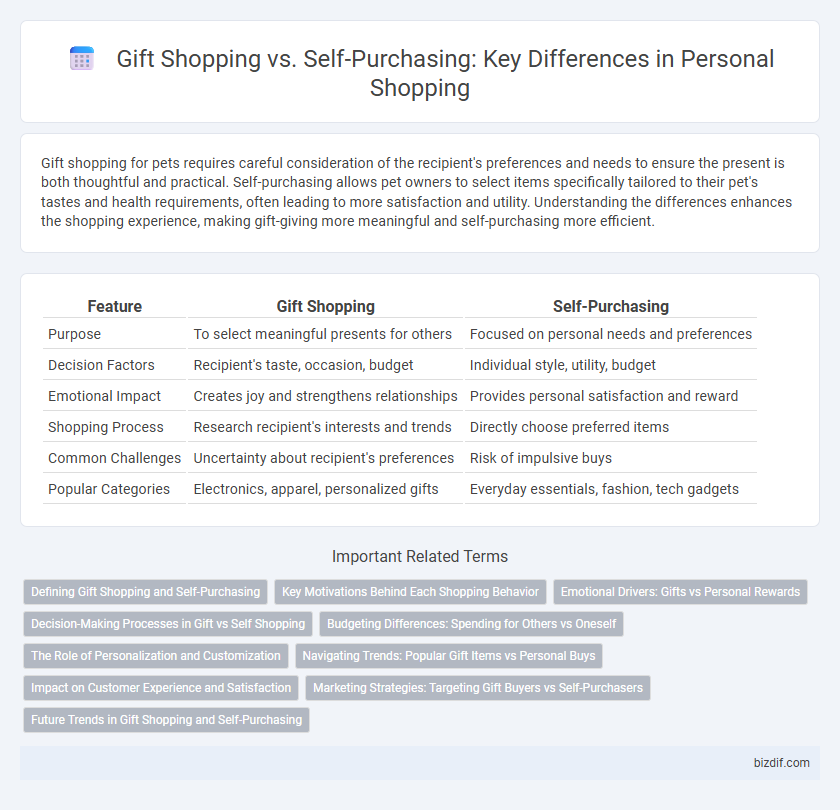Gift shopping for pets requires careful consideration of the recipient's preferences and needs to ensure the present is both thoughtful and practical. Self-purchasing allows pet owners to select items specifically tailored to their pet's tastes and health requirements, often leading to more satisfaction and utility. Understanding the differences enhances the shopping experience, making gift-giving more meaningful and self-purchasing more efficient.
Table of Comparison
| Feature | Gift Shopping | Self-Purchasing |
|---|---|---|
| Purpose | To select meaningful presents for others | Focused on personal needs and preferences |
| Decision Factors | Recipient's taste, occasion, budget | Individual style, utility, budget |
| Emotional Impact | Creates joy and strengthens relationships | Provides personal satisfaction and reward |
| Shopping Process | Research recipient's interests and trends | Directly choose preferred items |
| Common Challenges | Uncertainty about recipient's preferences | Risk of impulsive buys |
| Popular Categories | Electronics, apparel, personalized gifts | Everyday essentials, fashion, tech gadgets |
Defining Gift Shopping and Self-Purchasing
Gift shopping involves selecting items specifically intended to express appreciation or celebrate special occasions for others, emphasizing thoughtfulness and personalization. Self-purchasing centers on acquiring products primarily for personal use or enjoyment, driven by individual preferences and needs. Understanding the distinctions between these shopping behaviors is essential for tailoring marketing strategies and enhancing customer experiences.
Key Motivations Behind Each Shopping Behavior
Gift shopping is primarily driven by the desire to express appreciation, strengthen relationships, and celebrate special occasions, often influenced by social norms and the recipient's preferences. Self-purchasing centers on personal gratification, comfort, and the fulfillment of individual needs or desires, reflecting a shopper's unique style and priorities. Emotional connection and social expectations significantly differentiate the motivations behind gift shopping from the autonomy and self-expression found in self-purchasing.
Emotional Drivers: Gifts vs Personal Rewards
Gift shopping often fulfills the emotional driver of strengthening relationships and showing appreciation, fostering feelings of connection and gratitude. Self-purchasing, driven by personal rewards, provides instant gratification and reinforces self-worth through indulgence or achievement acknowledgment. Understanding these emotional distinctions helps tailor marketing strategies that resonate with consumers' motives, whether seeking to give meaningful gifts or reward themselves.
Decision-Making Processes in Gift vs Self Shopping
Gift shopping often involves considering the recipient's preferences, interests, and needs, adding layers of emotional and social factors that complicate the decision-making process. Self-purchasing decisions prioritize personal desires, budget constraints, and practical use, allowing for more straightforward, subjective evaluations. Cognitive empathy and anticipation of the recipient's reaction are key drivers in gift shopping, distinguishing it from the self-focused, intrinsic motivation found in self-purchasing behavior.
Budgeting Differences: Spending for Others vs Oneself
Gift shopping typically requires careful budgeting to accommodate the preferences and expectations of others, often leading to higher overall spending to ensure satisfaction and appropriateness. In contrast, self-purchasing allows for greater flexibility and personal prioritization, enabling individuals to allocate funds based on personal desires and immediate needs without external pressure. The psychological impact of spending for others often justifies larger budgets, while self-spending is usually more restrained and focused on value or necessity.
The Role of Personalization and Customization
Personalization and customization play crucial roles in both gift shopping and self-purchasing by tailoring products to meet individual preferences and needs. For gift shopping, customized items demonstrate thoughtfulness and enhance emotional value, making the gift more memorable and meaningful. In self-purchasing, personalization offers a unique and satisfying shopping experience by reflecting the buyer's style and personality, leading to higher customer satisfaction and brand loyalty.
Navigating Trends: Popular Gift Items vs Personal Buys
Gift shopping often revolves around trending items that appeal broadly, such as tech gadgets, personalized accessories, or sustainable products, ensuring the presents resonate with diverse tastes. In contrast, self-purchasing trends prioritize personal preferences and comfort, like bespoke clothing, wellness products, or home office enhancements tailored to individual lifestyles. Navigating these trends requires understanding market demand for gifts while aligning self-buys with evolving personal needs and style expressions.
Impact on Customer Experience and Satisfaction
Gift shopping enhances customer experience by fostering emotional connection and thoughtful selection, often leading to higher satisfaction due to the personal value attached to gifts. Self-purchasing prioritizes individual preferences and convenience, which increases satisfaction through immediate gratification and tailored choices. Both approaches significantly impact customer satisfaction by addressing different emotional and practical needs during the purchasing process.
Marketing Strategies: Targeting Gift Buyers vs Self-Purchasers
Marketing strategies for gift shopping prioritize emotional triggers and occasion-based messaging to appeal to buyers seeking meaningful, personalized presents for others. In contrast, campaigns targeting self-purchasers emphasize product benefits, self-rewarding narratives, and convenience to drive impulse or planned purchases. Data-driven segmentation and personalized recommendations enhance engagement by addressing the distinct motivations of gift buyers versus self-purchasers.
Future Trends in Gift Shopping and Self-Purchasing
Future trends in gift shopping emphasize personalized, AI-driven recommendations and sustainable packaging, catering to evolving consumer preferences for meaningful and eco-friendly presents. Self-purchasing is increasingly influenced by augmented reality and virtual try-ons, enhancing the shopping experience with convenience and customization. Both sectors leverage data analytics to predict trends and optimize inventory management, reflecting a shift toward more intelligent and customer-centric retail strategies.
Gift shopping vs Self-purchasing Infographic

 bizdif.com
bizdif.com